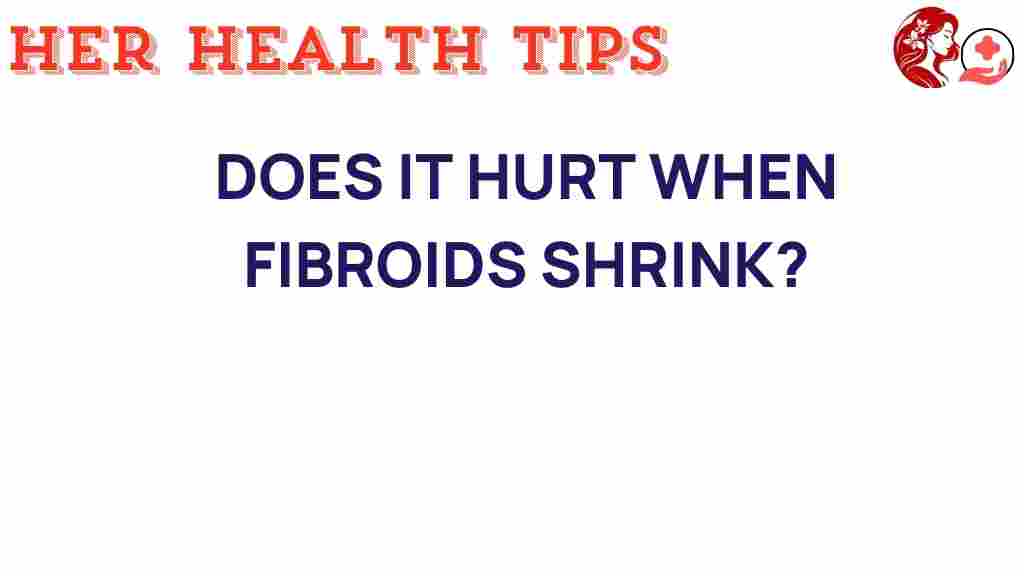The Hidden Truth: Do Fibroids Shrink Painfully?
Fibroids are non-cancerous growths that develop in or on the uterus, affecting a significant number of women during their reproductive years. These growths can lead to various symptoms, including pain, and their management is an important aspect of women’s health and wellness. In this article, we will explore whether fibroids shrink painfully, the symptoms associated with them, available treatments, and how to diagnose their presence effectively.
Understanding Fibroids
Fibroids, also known as uterine leiomyomas or myomas, are made up of muscle and fibrous tissue. While their exact cause is still being studied, it is believed that hormones, particularly estrogen and progesterone, play a crucial role in their growth.
Fibroids can vary in size, shape, and location within the uterus. Some women may have multiple fibroids, while others may have only one. The impact of fibroids on a woman’s health can vary widely, and many women may experience no symptoms at all.
Common Symptoms of Fibroids
While it is possible to have fibroids and not know it, many women experience symptoms that can significantly affect their quality of life. Common symptoms include:
- Pelvic pain: This can range from mild to severe and may be constant or intermittent.
- Heavy menstrual bleeding: Many women with fibroids report heavy periods, which can lead to anemia.
- Frequent urination: This occurs when fibroids press on the bladder.
- Back pain: Discomfort in the lower back can occur if the fibroids are large.
- Pressure or fullness in the abdomen: This may feel like bloating or fullness.
If you experience any of these symptoms, it is crucial to consult a healthcare provider for proper diagnosis and treatment options.
Do Fibroids Shrink Painfully?
The question of whether fibroids shrink painfully is complex. Fibroids can shrink on their own, especially after menopause when estrogen levels decrease. This natural shrinkage is generally not painful. However, there are instances where fibroids may cause discomfort or pain during their reduction phase.
During the shrinking process, which can be influenced by hormonal changes or medical treatments, some women report:
- Increased pelvic pressure: As fibroids shrink, they may shift or move, causing discomfort.
- Menstrual changes: Changes in menstrual flow can occur, sometimes leading to cramping or pain.
- Pressure on nearby organs: If a fibroid is large, it may still exert pressure on other organs, causing pain even as it shrinks.
In summary, while fibroid shrinkage itself is not typically painful, associated changes can lead to discomfort for some women.
Diagnosis of Fibroids
Diagnosing fibroids involves several steps and may include:
- Medical history: Your doctor will ask about your symptoms, menstrual history, and family history.
- Physical examination: A pelvic exam may reveal an enlarged uterus or masses.
- Imaging tests: Ultrasound, MRI, or CT scans can provide detailed images of the uterus and help identify fibroids.
Early diagnosis is essential for effective treatment and management of symptoms associated with fibroids.
Treatment Options for Fibroids
There are various treatment options available for managing fibroids, depending on the severity of symptoms, the size and location of the fibroids, and the woman’s overall health and reproductive plans.
1. Watchful Waiting
If fibroids are small and not causing significant symptoms, a doctor may recommend a watchful waiting approach. Regular check-ups will help monitor any changes in size or symptoms.
2. Medications
Several medications can help manage symptoms:
- Hormonal treatments: Birth control pills or hormonal IUDs can help regulate menstrual cycles and reduce heavy bleeding.
- GnRH agonists: These medications can shrink fibroids by lowering estrogen levels, but they are usually a temporary solution.
- Nonsteroidal anti-inflammatory drugs (NSAIDs): These can help relieve pain and cramping associated with fibroids.
3. Non-Invasive Procedures
Some non-invasive procedures can help manage fibroids without requiring surgery:
- Uterine artery embolization: This procedure blocks blood flow to fibroids, causing them to shrink.
- Focused ultrasound surgery: This technique uses ultrasound waves to destroy fibroid tissue.
4. Surgical Options
If fibroids are large or causing significant symptoms, surgical options may be considered:
- Myomectomy: This surgery removes fibroids while preserving the uterus, suitable for women who wish to maintain fertility.
- Hysterectomy: This is the removal of the uterus, which is a definitive solution for fibroids but eliminates the possibility of future pregnancies.
Wellness and Fibroids
Maintaining a healthy lifestyle can help manage fibroids and overall women’s health. Consider the following wellness tips:
- Healthy diet: Focus on a balanced diet rich in fruits, vegetables, whole grains, and lean proteins.
- Regular exercise: Physical activity can help manage weight and reduce symptoms.
- Stress management: Techniques such as yoga, meditation, and deep breathing can help reduce stress, which may affect hormone levels.
Troubleshooting Tips for Managing Pain
If you are experiencing pain related to fibroids, here are some tips to help manage discomfort:
- Heat therapy: Applying a heating pad to the lower abdomen can soothe cramps.
- Hydration: Drink plenty of water to help reduce bloating and discomfort.
- Over-the-counter pain relief: NSAIDs can help alleviate pain and reduce inflammation.
- Seek medical advice: If pain persists or worsens, consult a healthcare professional for further evaluation.
Conclusion
Fibroids are a common issue that can lead to a range of symptoms, including pain. While fibroids can shrink, this process is typically not painful, though associated changes may cause discomfort. Understanding the symptoms, diagnosis, and treatment options available is crucial for women’s health and wellness.
For more information on fibroids and their management, consider visiting the National Uterine Fibroids Foundation for resources and support.
If you suspect you have fibroids or are experiencing symptoms, do not hesitate to seek medical advice. Early diagnosis and intervention can significantly improve your quality of life and help you manage your health effectively.
For further reading on women’s health issues, check out our article on living well with fibroids.
This article is in the category Reproductive and created by HerHealthTips Team
